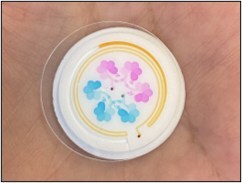Business
Researchers Unveil Advanced Microfluidic Systems for Sweat Analysis

Innovative research from Chung-Ang University has led to the development of next-generation microfluidic systems designed to enhance sweat analysis. This breakthrough, spearheaded by Dr. Da Som Yang, an Assistant Professor in the School of Mechanical Engineering, aims to improve the monitoring of health indicators through sweat, which is rich in important biochemical components.
Eccrine sweat, secreted by eccrine sweat glands, acts as a non-invasive biofluid containing electrolytes, metabolites, and organic molecules. The ability to quantitatively measure these constituents with wearable microfluidic sensors opens the door to real-time health monitoring. Applications of this technology span various sectors, including sports, safety in hazardous work environments, environmental assessments, and healthcare.
Despite the promising applications of microfluidic sensors, challenges remain. Current technologies often struggle with the efficient collection of sweat and accurate detection of a broad range of biochemicals. The need for precise local measurements of sweat loss is critical, especially given the varying sweat rates among individuals.
To address these limitations, the research team explored a variety of 3D microfluidic structures, surface chemistries, and interface designs. Their work was published in the journal Advanced Functional Materials on July 16, 2025. Dr. Yang emphasized the necessity of this research, stating, “The concentrations of biomarkers in sweat can change dynamically over time, particularly after the intake of food or supplements. Existing techniques often lack the accuracy and dynamic range needed to capture these fluctuations effectively.”
The researchers have successfully demonstrated innovative methods for sweat collection and analysis. Their systems enable simultaneous measurement of sweat rate, total sweat loss, and critical biomarkers, such as chloride, xanthine, and creatinine. This advancement offers a non-invasive way to monitor vital health indicators, including kidney function and electrolyte balance. On-body trials have confirmed the technology’s ability to track changes in biomarker concentrations after food or supplement consumption.
Dr. Yang pointed out the diverse applications of this technology, noting its potential in managing athletic performance, preventing heat stress in high-temperature environments, and monitoring chronic health conditions like kidney disease. The research not only presents a tool for real-time tracking of metabolic changes but also enhances the prospects for personalized healthcare and preventive medicine.
This study marks a significant step forward in expanding sweat-based diagnostic strategies, paving the way for integration with established manufacturing practices for large-scale production. In the long run, the platform developed by the researchers could find applications across various sectors, including medicine, sports science, and wellness.
Overall, this innovative microfluidic technology stands to revolutionize the way health monitoring is approached, making it more accessible and efficient for individuals and healthcare providers alike.
-

 Lifestyle5 months ago
Lifestyle5 months agoLibraries Challenge Rising E-Book Costs Amid Growing Demand
-

 Sports4 months ago
Sports4 months agoTyreek Hill Responds to Tua Tagovailoa’s Comments on Team Dynamics
-

 Sports4 months ago
Sports4 months agoLiverpool Secures Agreement to Sign Young Striker Will Wright
-

 Lifestyle4 months ago
Lifestyle4 months agoSave Your Split Tomatoes: Expert Tips for Gardeners
-

 Lifestyle4 months ago
Lifestyle4 months agoPrincess Beatrice’s Daughter Athena Joins Siblings at London Parade
-

 Science4 months ago
Science4 months agoSan Francisco Hosts Unique Contest to Identify “Performative Males”
-

 World4 months ago
World4 months agoWinter Storms Lash New South Wales with Snow, Flood Risks
-

 Science5 months ago
Science5 months agoTrump Administration Moves to Repeal Key Climate Regulation
-

 Business5 months ago
Business5 months agoSoFi Technologies Shares Slip 2% Following Insider Stock Sale
-

 Science5 months ago
Science5 months agoNew Tool Reveals Link Between Horse Coat Condition and Parasites
-

 Sports4 months ago
Sports4 months agoElon Musk Sculpture Travels From Utah to Yosemite National Park
-

 Science5 months ago
Science5 months agoNew Study Confirms Humans Transported Stonehenge Bluestones









